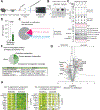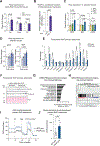Isolation of extracellular fluids reveals novel secreted bioactive proteins from muscle and fat tissues
- PMID: 36681077
- PMCID: PMC9998376
- DOI: 10.1016/j.cmet.2022.12.014
Isolation of extracellular fluids reveals novel secreted bioactive proteins from muscle and fat tissues
Abstract
Proteins are secreted from cells to send information to neighboring cells or distant tissues. Because of the highly integrated nature of energy balance systems, there has been particular interest in myokines and adipokines. These are challenging to study through proteomics because serum or plasma contains highly abundant proteins that limit the detection of proteins with lower abundance. We show here that extracellular fluid (EF) from muscle and fat tissues of mice shows a different protein composition than either serum or tissues. Mass spectrometry analyses of EFs from mice with physiological perturbations, like exercise or cold exposure, allowed the quantification of many potentially novel myokines and adipokines. Using this approach, we identify prosaposin as a secreted product of muscle and fat. Prosaposin expression stimulates thermogenic gene expression and induces mitochondrial respiration in primary fat cells. These studies together illustrate the utility of EF isolation as a discovery tool for adipokines and myokines.
Keywords: PGC1α; cold adaptation; exercise; extracellular fluid; prosaposin; proteomics; secreted proteins; secretome.
Copyright © 2022 Elsevier Inc. All rights reserved.
Conflict of interest statement
Declaration of interests B.M.S. holds patents related to irisin (WO2015051007A1). B.M.S. is an academic co-founder and consultant for Aevum Therapeutics. E.T.C. is a co-founder, equity holder, and board member of Matchpoint Therapeutics and a co-founder and equity holder in Aevum Therapeutics.
Figures





References
-
- de Oliveira Dos Santos AR, de Oliveira Zanuso B, Miola VFB, Barbalho SM, Santos Bueno PC, Flato UAP, Detregiachi CRP, Buchaim DV, Buchaim RL, Tofano RJ, et al. (2021). Adipokines, Myokines, and Hepatokines: Crosstalk and Metabolic Repercussions. Int J Mol Sci 22. 10.3390/ijms22052639. - DOI - PMC - PubMed

